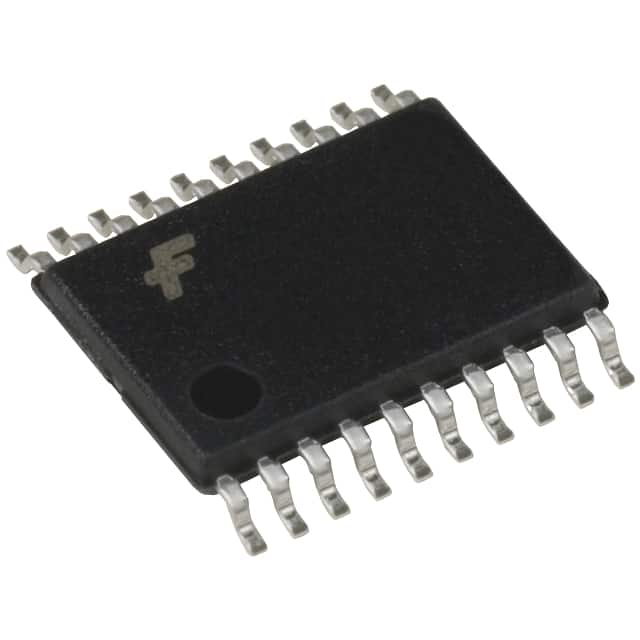Lihat spesifikasi untuk detail produk.

Encyclopedia Entry: 74ALVC2245MTC
Product Overview
Category
The 74ALVC2245MTC belongs to the category of integrated circuits (ICs) and specifically falls under the group of bus transceivers.
Use
This IC is commonly used for bidirectional voltage level translation between different logic levels in various digital systems.
Characteristics
- Bidirectional voltage level translation
- Wide operating voltage range
- High-speed operation
- Low power consumption
- ESD protection
- RoHS compliant
Package
The 74ALVC2245MTC is available in a TSSOP (Thin Shrink Small Outline Package) package.
Essence
The essence of this product lies in its ability to facilitate seamless communication between digital systems operating at different voltage levels.
Packaging/Quantity
The 74ALVC2245MTC is typically packaged in reels or tubes, with each reel/tube containing a specific quantity of ICs. The exact packaging and quantity may vary depending on the manufacturer.
Specifications
- Supply Voltage Range: 1.2V to 3.6V
- Input Voltage Range: -0.5V to VCC + 0.5V
- Output Voltage Range: -0.5V to VCC + 0.5V
- Operating Temperature Range: -40°C to +85°C
- Number of Channels: 8
- Logic Family: ALVC
Detailed Pin Configuration
The 74ALVC2245MTC has a total of 20 pins, which are assigned specific functions as follows:
- OE (Output Enable) 1
- A1 (Data Input/Output) 1
- B1 (Data Input/Output) 1
- GND (Ground)
- B2 (Data Input/Output) 2
- A2 (Data Input/Output) 2
- OE (Output Enable) 2
- VCC (Supply Voltage)
- DIR (Direction Control)
- B3 (Data Input/Output) 3
- A3 (Data Input/Output) 3
- GND (Ground)
- A4 (Data Input/Output) 4
- B4 (Data Input/Output) 4
- OE (Output Enable) 4
- VCC (Supply Voltage)
- B5 (Data Input/Output) 5
- A5 (Data Input/Output) 5
- DIR (Direction Control)
- GND (Ground)
Functional Features
- Bidirectional data transfer between different voltage domains
- Automatic direction control based on the DIR pin
- Output enable/disable functionality for individual channels
- High-speed operation for efficient data transmission
- ESD protection to safeguard against electrostatic discharge
Advantages and Disadvantages
Advantages
- Wide operating voltage range allows compatibility with various systems
- Low power consumption for energy-efficient applications
- ESD protection ensures reliability in harsh environments
- Bidirectional data transfer simplifies system design
Disadvantages
- Limited number of channels (8 in this case)
- Requires careful consideration of voltage levels to avoid signal degradation
Working Principles
The 74ALVC2245MTC operates by utilizing a combination of transistors and logic gates to facilitate bidirectional voltage level translation. The DIR pin controls the direction of data flow, while the OE pins enable or disable the output of individual channels. The IC's internal circuitry ensures proper voltage level shifting, allowing seamless communication between different logic levels.
Detailed Application Field Plans
The 74ALVC2245MTC finds application in various digital systems where voltage level translation is required. Some common application fields include:
- Microcontroller interfacing
- Memory modules
- Communication systems
- Industrial automation
- Consumer electronics
Detailed and Complete Alternative Models
- 74LVC245: Similar functionality with a different logic family (LVC)
- SN74LVCH245A: Bidirectional bus transceiver with 3-state outputs
- CD74HCT245: High-speed CMOS logic level shifter
These alternative models offer similar features and can be considered as substitutes for the 74ALVC2245MTC depending on specific requirements.
Word count: 570 words
Sebutkan 10 pertanyaan dan jawaban umum terkait penerapan 74ALVC2245MTC dalam solusi teknis
Sure! Here are 10 common questions and answers related to the application of 74ALVC2245MTC in technical solutions:
Q: What is the function of the 74ALVC2245MTC? A: The 74ALVC2245MTC is an octal bus transceiver with 3-state outputs, which means it can control the bidirectional flow of data between two buses.
Q: What is the voltage range supported by the 74ALVC2245MTC? A: The 74ALVC2245MTC supports a wide voltage range from 1.65V to 3.6V, making it compatible with various logic families.
Q: How many channels does the 74ALVC2245MTC have? A: The 74ALVC2245MTC has 8 bidirectional channels, allowing for simultaneous data transfer in both directions.
Q: Can the 74ALVC2245MTC handle high-speed data transmission? A: Yes, the 74ALVC2245MTC is designed to support high-speed data transmission up to 400 Mbps, making it suitable for applications requiring fast data transfer.
Q: Does the 74ALVC2245MTC have built-in ESD protection? A: Yes, the 74ALVC2245MTC incorporates ESD protection on all inputs and outputs, ensuring robustness against electrostatic discharge.
Q: Can I use the 74ALVC2245MTC in mixed-voltage level applications? A: Yes, the 74ALVC2245MTC has voltage translation capabilities, allowing it to interface between different voltage domains.
Q: What is the power supply voltage required for the 74ALVC2245MTC? A: The 74ALVC2245MTC operates with a single power supply voltage of 1.65V to 3.6V, simplifying the power requirements in most applications.
Q: Does the 74ALVC2245MTC support hot insertion and removal of devices? A: Yes, the 74ALVC2245MTC is designed to support hot insertion and removal, ensuring smooth operation during system maintenance or upgrades.
Q: Can I use the 74ALVC2245MTC in battery-powered applications? A: Absolutely! The 74ALVC2245MTC has low power consumption characteristics, making it suitable for battery-operated devices where power efficiency is crucial.
Q: Are there any specific layout considerations when using the 74ALVC2245MTC? A: Yes, it is recommended to follow the manufacturer's guidelines for proper PCB layout, including minimizing trace lengths, providing adequate decoupling capacitors, and maintaining signal integrity for optimal performance.
Please note that these answers are general and may vary depending on the specific application and requirements. It is always advisable to refer to the datasheet and consult with the manufacturer for detailed information.

